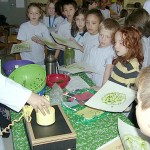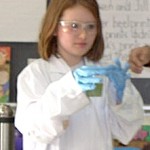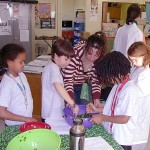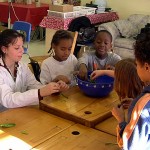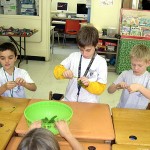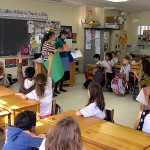Chlorophyl
October 6, 2011 in Plants
On Wednesday, November 12th, 2008, the students in Mrs Shuster’s third grade class at École F.A.C.E. School shined, radiating with knowledge of “chlorophyl” provided by university students April Clyburne-Sherin (BA Art Education, Concordia U.) and Vanessa Kairouz (B.Sc., U. Montréal). April and Vanessa led the students through the cycle of respiration and photosynthesis explaining how animals take in oxygen and sugar producing carbon dioxide and water which the plants take in to produce oxygen and sugar. Chlorophyl was presented as the molecule that harnesses energy from light for the conversion of carbon dioxide and water into oxygen and sugar. Employing spinach leaves, the students were led through an extraction which started with everyone tearing up leaves and finished by students in proper lab-attire using rubbing alcohol (iso-propanol) and water to extract out the green colored chlorophyl. Employing the extract as paint, the students then painted pictures of their favorite food. The pictures were next examined under a black light bulb and appeared to luminance an orange red colour. April and Vanessa explained how under blacklight the chlorophyll reacts with light absorbing its energy and later releasing the energy by glowing and producing heat.
Using modern dance to help the students interpret the relationship between the molecules in the photosynthesis and respiration cycles, team chlorophyl inspired students to behave as molecules by exchanging cards containing their atoms as they converted themselves from oxygen and sugar to carbon dioxide and water and back again.
Illuminated like chlorophyl, we all thanked team chlorophyl for shining some light on the wonders of photosynthesis and plant chemistry.
Note: the chloro portion of the word is from the Greek chloros, which means yellowish green. The name of the element chlorine also comes from the same source. Chlorine is a yellowish green gas. There is no chlorine in chlorophyl, but there is magnesium.
For more information see: http://scifun.chem.wisc.edu/CHEMWEEK/CHLRPHYL/Chlrphyl.html
For chlorophyl experiment see:
http://c-lab.co.uk/default.aspx?id=9&projectid=58










